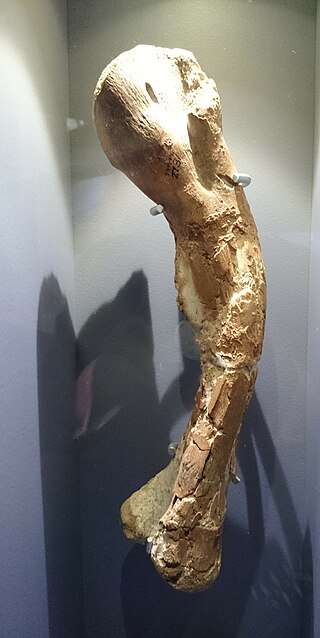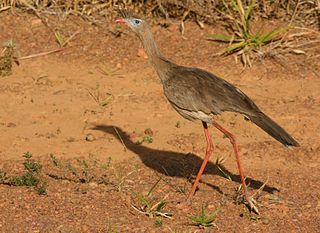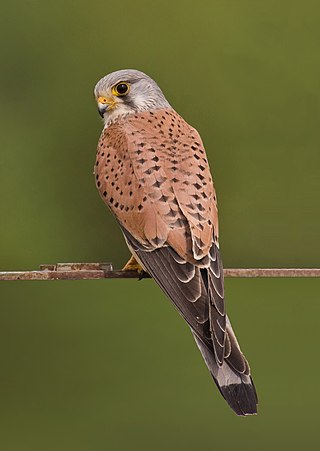
The seriemas are the sole living members of the small bird family Cariamidae, which is also the only surviving lineage of the order Cariamiformes. Once believed to be related to cranes, they have been placed near the falcons, parrots, and passerines, as well as the extinct Phorusrhacidae. The seriemas are large, long-legged territorial birds that range from 70–90 cm (28–35 in) in length. They live in grasslands, savanna, dry woodland and open forests of Brazil, Bolivia, Argentina, Paraguay and Uruguay. There are two species of seriemas, the red-legged seriema and the black-legged seriema. Names for these birds in the Tupian languages are variously spelled as siriema, sariama, and çariama, and mean "crested".

Ovenbirds or furnariids are a large family of small suboscine passerine birds found from Mexico and Central to southern South America. They form the family Furnariidae. This is a large family containing around 315 species and 70 genera. The ovenbird, which breeds in North America, is not a furnariid – rather it is a distantly related bird of the wood warbler family, Parulidae.

Fulgurotherium is a dubious genus of ornithischian dinosaur from the Late Cretaceous (Cenomanian) Griman Creek Formation. It lived in what is now Australia.

Talenkauen is a genus of basal iguanodont dinosaur from the Campanian or Maastrichtian age of the Late Cretaceous Cerro Fortaleza Formation, formerly known as the Pari Aike Formation of Patagonian Lake Viedma, in the Austral Basin of Santa Cruz, Argentina. It is based on MPM-10001A, a partial articulated skeleton missing the rear part of the skull, the tail, and the hands. The type and only species is Talenkauen santacrucensis.

Kangnasaurus is a genus of iguanodontian ornithopod dinosaur found in supposedly Early Cretaceous rocks of South Africa. It is known from a tooth and possibly some postcranial remains found in the early-Aptian Kalahari Deposits Formation. It was probably similar to Dryosaurus.

Anthropornis is a genus of giant penguin that lived 45-33 million years ago, during the Late Eocene and the earliest part of the Oligocene.

The red-legged seriema, also known as the crested cariama and crested seriema, is a mostly predatory terrestrial bird in the seriema family (Cariamidae), included in the Gruiformes in the old polyphyletic circumscription but recently placed in a distinct order: Cariamiformes.
Opisthodactylus is an extinct genus of rheiform bird from the Early to Middle Miocene Santa Cruz and Chichinales Formations and the Late Miocene (Montehermosan) Andalhuala Formation of Argentina. Three species are described: the type species, O. patagonicus, O. kirchneri and O. horacioperezi. The species O. kirchneri was described in 2017 by Noriega et al. Fossils of O. horacioperezi were found together with fossils of Patagorhacos terrificus.

Procariama is an extinct monotypic genus of phorusrhacid, which lived from the Late Miocene to the Late Pliocene of Argentina. Fossils of the animal have been found in six places, in the Cerro Azul and Andalhuala Formations. More specifically in the Andagalá department and in the north of the Belén department of the Catamarca province, with a single location in the La Pampa province. The type and only species, Procariama simplex, is the largest member of the subfamily Psilopterinae.

Psilopterus is an extinct genus of phorusrhacid from the Middle Oligocene to possibly the Late Pleistocene of Argentina and Uruguay. Compared to other phorusrhacids, members of the genus are both relatively gracile and diminutive, and include the smallest known species of terror bird: with the head raised P. bachmanni was 70–80 centimeters (2.3–2.6 ft) in height and weighed about 5 kilograms (11 lb), while the largest members of the genus were only about 8 kilograms (18 lb). The birds resemble the modern cariama, except with a heavier build and considerably smaller wings. Fossil finds in Uruguay indicate the genus may have survived until 96,040 ± 6,300 years ago, millions of years after the larger phorusrhacids became extinct.
The Santacrucian age is a period of geologic time within the Early Miocene epoch of the Neogene, used more specifically with SALMA classification in South America. It follows the Colhuehuapian and precedes the Friasian age.

Elasmaria is a clade of ornithopods known from Cretaceous deposits in South America, Antarctica, and Australia that contains many bipedal ornithopods that were previously considered "hypsilophodonts".

Eleutherocercus was a genus of glyptodonts that lived during the Late Miocene and Early Pliocene in South America. Fossils of the genus have been found in the Huayquerian Ituzaingó Formation and the Montehermosan Monte Hermoso Formation in Argentina.

Australaves is a clade of birds, defined in 2012, consisting of the Eufalconimorphae as well as the Cariamiformes. They appear to be the sister group of Afroaves. This clade was defined in the PhyloCode by George Sangster and colleagues in 2022 as "the least inclusive crown clade containing Cariama cristata and Passer domesticus".
Leptoptilos patagonicus is an extinct species of large-bodied Leptoptilini stork that existed during the Late Miocene. Fossils of the species were discovered in the San Madryn Formation in Chubut Province, Argentina. L. patagonicus is the first fossil record discovery of a member of Leptoptilos in South America and the only one found so far in the New World.
Elaphrocnemus is a genus of extinct bird from the Eocene and Oligocene periods of Europe. Part of Cariamiformes, its closest living relatives are seriemas, though it differs significantly from them, being a better flyer.
Pseudoseisuropsis is a genus of extinct birds in the ovenbird family from the Pleistocene of Argentina and Uruguay. The genus was described in 1991 based on disarticulated skeletal elements and a nearly-complete skull. Although originally believed to be closely related to the extant genus Pseudoseisura, phylogenetic analyses suggested a more basal origin within the family.

Hegetotherium is an extinct genus of mammals from the Early to Middle Miocene of South America. Fossils of this genus have been found in the Cerro Bandera, Cerro Boleadoras, Chichinales, Collón Curá, Santa Cruz and Sarmiento Formations of Argentina, the Nazareno Formation of Bolivia, and the Galera and Río Frías Formations of Chile.
Giganhinga is a genus of giant darter that lived during the Late Miocene to Early Pleistocene in what is now Uruguay and Argentina. The largest species of anhinga known to science, estimates suggest it may have weighed around 17.7 kg (39 lb) and was likely flightless. Its weight likely helped it dive for prey and the anatomy of the pelvis indicates that it was a good and maneuverable swimmer. Only a single species is currently recognized, G. kiyuensis.
Miocariama is an extinct genus of seriema that lived in the Early Miocene and Late Pliocene. The only species in the genus is Miocariama patagonica.












